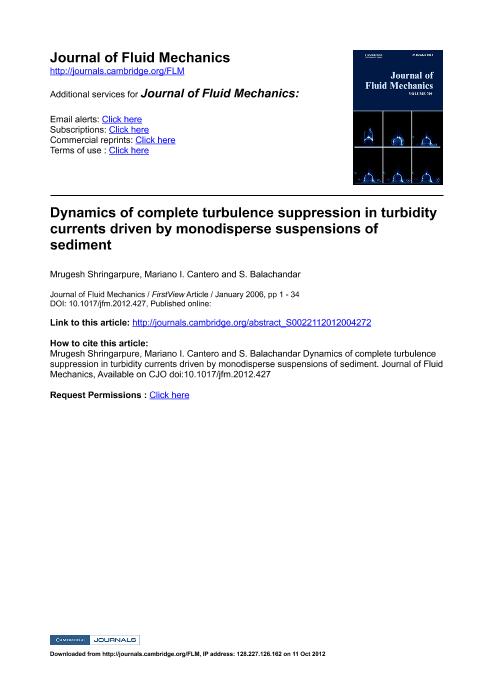Mostrar el registro sencillo del ítem
dc.contributor.author
Shringarpure, Mrugesh
dc.contributor.author
Cantero, Mariano Ignacio

dc.contributor.author
Balachandar, S.
dc.date.available
2023-05-10T18:00:36Z
dc.date.issued
2012-09
dc.identifier.citation
Shringarpure, Mrugesh; Cantero, Mariano Ignacio; Balachandar, S.; Dynamics of complete turbulence suppression in turbidity currents driven by monodisperse suspensions of sediment; Cambridge University Press; Journal of Fluid Mechanics; 712; 9-2012; 384-417
dc.identifier.issn
0022-1120
dc.identifier.uri
http://hdl.handle.net/11336/197054
dc.description.abstract
Turbidity currents derive their motion from the excess density imposed by suspended sediments. The settling tendency of sediments is countered by flow turbulence, which expends energy to keep them in suspension. This interaction leads to downward increasing concentration of suspended sediments (stable stratification) in the flow. Thus in a turbidity current sediments play the dual role of sustaining turbulence by driving the flow and damping turbulence due to stable stratification. By means of direct numerical simulations, it has been shown previously that stratification above a threshold can substantially reduce turbulence and possibly extinguish it. This study expands the simplified model by Cantero et al. (J. Geophys. Res., vol.114, 2009a, C03008), and puts forth a proposition that explains the mechanism of complete turbulence suppression due to suspended sediments. In our simulations it is observed that suspensions of larger sediments lead to stronger stratification and, above a threshold size, induce an abrupt transition in the flow to complete turbulence suppression. It has been widely accepted that hairpin and quasi-streamwise vortices are key to sustaining turbulence in wall-bounded flows, and that only vortices of sufficiently strong intensity can spawn the next generation of vortices. This auto-generation mechanism keeps the flow populated with hairpin and quasi-streamwise vortical structures and thus sustains turbulence. From statistical analysis of Reynolds stress events and visualization of flow structures, it is observed that settling sediments damp the Reynolds stress events (Q2 events), which means a reduction in both the strength and spatial distribution of vortical structures. Beyond the threshold sediment size, the existing vortical structures in the flow are damped to an extent where they lose their ability to regenerate the subsequent generation of turbulent vortical structures, which ultimately leads to complete turbulence suppression.
dc.format
application/pdf
dc.language.iso
eng
dc.publisher
Cambridge University Press

dc.rights
info:eu-repo/semantics/openAccess
dc.rights.uri
https://creativecommons.org/licenses/by-nc-sa/2.5/ar/
dc.subject
GEOPHYSICAL AND GEOLOGICAL FLOWS
dc.subject
TURBIDITY CURRENTS
dc.subject
TURBULENCE SUPPRESSION
dc.subject.classification
Ingeniería Mecánica

dc.subject.classification
Ingeniería Mecánica

dc.subject.classification
INGENIERÍAS Y TECNOLOGÍAS

dc.title
Dynamics of complete turbulence suppression in turbidity currents driven by monodisperse suspensions of sediment
dc.type
info:eu-repo/semantics/article
dc.type
info:ar-repo/semantics/artículo
dc.type
info:eu-repo/semantics/publishedVersion
dc.date.updated
2023-05-10T15:52:08Z
dc.journal.volume
712
dc.journal.pagination
384-417
dc.journal.pais
Reino Unido

dc.journal.ciudad
Cambridge
dc.description.fil
Fil: Shringarpure, Mrugesh. University of Florida; Estados Unidos
dc.description.fil
Fil: Cantero, Mariano Ignacio. Comisión Nacional de Energía Atómica. Gerencia del Área de Energía Nuclear. Instituto Balseiro. Archivo Histórico del Centro Atómico Bariloche e Instituto Balseiro | Universidad Nacional de Cuyo. Instituto Balseiro. Archivo Histórico del Centro Atómico Bariloche e Instituto Balseiro; Argentina. Consejo Nacional de Investigaciones Científicas y Técnicas. Centro Científico Tecnológico Conicet - Patagonia Norte; Argentina
dc.description.fil
Fil: Balachandar, S.. University of Florida; Estados Unidos
dc.journal.title
Journal of Fluid Mechanics

dc.relation.alternativeid
info:eu-repo/semantics/altIdentifier/doi/http://dx.doi.org/10.1017/jfm.2012.427
Archivos asociados
